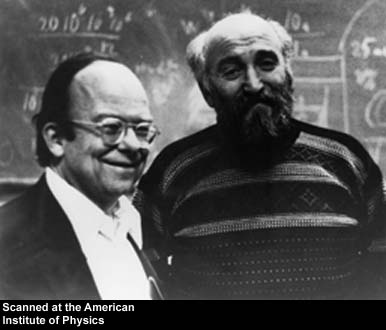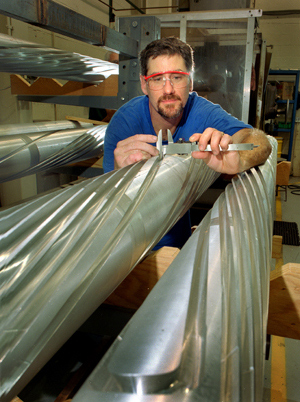Director's Corner
7 October 2010
 Barry Barish |
Novosibirsk
I had the interesting experience recently of spending four days at a meeting in Novosibirsk, Russia. I was an invited speaker at the 13th CERN-ISTC SAC seminar entitled "New Perspectives of High Energy Physics." The seminar was held at the Budker Institute for Nuclear Physics (BINP), a famous laboratory credited with many of the innovations in modern particle accelerators. I will write separately about the ISTC (International Science and Technology Center) seminar. This week I focus on our venue, and its history and impressive contributions to particle accelerators. Those of us who have worked on or done research using particle accelerators are well aware of the various schemes invented and developed in Novosibirsk.
 Pief Panofsky with Gersh Budker at the Institution of Nuclear Physics in Novosibirsk. Pief Panofsky with Gersh Budker at the Institution of Nuclear Physics in Novosibirsk. |
 The entrance to the BINP in winter. The entrance to the BINP in winter. |
Gersh Budker was a giant in the field of accelerator physics, having made many transformative contributions to the science. His ideas and innovations are still finding their way into our most modern accelerators, including the ILC. He became the founder and first director of the Institute of Nuclear Physics in Akademgorodok, Russia, in 1959, an institute that was renamed as the Budker Institute for Nuclear Physics after his death.
Budker was uniformly thought of as a brilliant physicist and an original thinker, and he was known for having a playful approach to science and life. Budker made many contributions to modern physics and accelerators, including the stabilised electron beam, the magnetic mirror plasma trap, colliding beams of electrons and positrons, and electron cooling for proton beams. Interestingly, an early concept for a linear electron-positron collider was suggested by Skrinsky, Budker and Balakin more than 30 years ago. Skrinsky and Budker also developed an early concept for a muon collider using ionisation muon cooling in the 1970s. So the ideas of Budker (and Skrinsky) are still alive and well in the form of the ambitious efforts to develop a next-generation lepton collider.
The style and imaginative approach at BINP continues. Maybe symbolically, Budker installed a large four metre diameter round table where brainstorming discussions of new ideas among researchers were encouraged and took place, and I witnessed that such a table is still in use. The BINP laboratory is now directed by Sasha Skrinsky, a protégé of Budker, and he hosted the ISTC meeting. He has continued the traditions of Budker and the laboratory scientists have developed a whole series of accelerators and colliders. They also have ambitious plans for the future, including a next-generation charm/tau factory.
Particle physics owes a tremendous debt to BINP for its leadership, symbolised by the many ideas of Budker, Skrinsky, Balakin and others. In a sense, the laboratory's impact is omnipresent in today's particle accelerators. One commonly seen example is the so-called "Siberian Snake." Siberian Snakes were invented at Novosibirsk in the late 1970s in order to manipulate accelerating particles' spin directions. A Siberian Snake consists of a set of quadrupoles and solenoids that compensate for other spin-changing effects that are often present in accelerating particles in a storage ring. A very successful modern implementation has been in the RHIC accelerator at Brookhaven National Laboratory, which is the world's first high-energy polarised proton collider.
It was thrilling for me to finally have the opportunity to visit BINP, a treasure of our field. I fully expect this dynamic place to continue their well established record of generating new forward looking ideas and techniques. It is useful advice for those of us who are working towards future accelerator projects to involve BINP where possible, as well as to keep a close eye on what new and imaginative schemes are being developed in Novosibirsk.
-- Barry Barish
